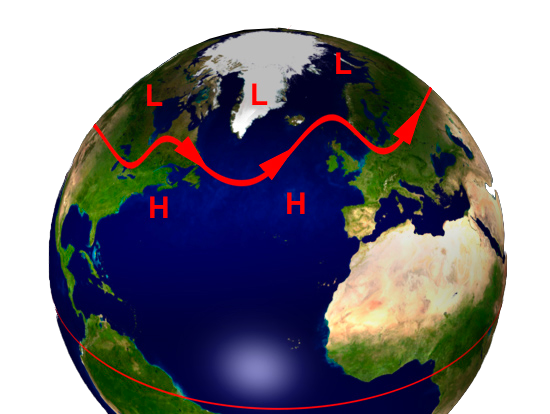Scientists have been warning us for over thirty years now that our emissions of carbon dioxide were going to inflict destructive change upon the climate. During those thirty years, conservatives, Republicans, and business interests have done everything they could to cast doubts on the science and slow the response to it. Even now, in 2022, when the destruction is evidence, Republicans (and even one Democratic Senator) still block action on climate change. Well, now we have frightening evidence of how bad things have gotten. I’m not talking about the wildfires, floods, rising sea levels, melting glaciers, and droughts that beset us. I’m talking about the must fundamental driver of climate: the jet stream.
Global Atmospheric Circulation
In order to understand what we’ve done, I have to start with something called the “global atmospheric circulation”. The basic underlying concept is simple: hot air expands and cold air contracts. Next, add the fact that the tropics are hotter than the poles, and you come to an obvious conclusion: the hot air of the tropics will somehow push towards the poles. However, the way it accomplishes this is complicated by the thinness of our atmosphere and the rotation of the earth. Here’s a basic diagram of the global atmospheric circulation:
You might expect that the warm air from the tropics would just go all the way to the poles, but it’s not that simple, because the earth is a sphere, not flat, so the air from the tropics gets squeezed and it cools as it moves poleward. This causes the circulation to break up into three cells between the tropics and the poles. Think of them as gears that transfer heat from the tropics to the poles. This diagram is highly schematic; for a variety of reasons, the real world circulation is more complicated. This gives you the basic idea.
The Jet Stream
The line where the Hadley cell meets the Ferrel cell is where the air dives downwards. This map shows it diving down at 30º latitude, but in reality that line is more of a wiggly curve. As it dives down, the rotation of the earth imparts an eastward spin to it, forcing much of it to move eastward at high speed even as it dives down. This eastward motion is a wind called the jet stream. It is at about 30,000 feet up and moves at over 100 mph. If you’re flying an airplane eastward, you definitely want to hitch a ride on the jet stream; if you’re going westward, you really want to avoid the jet stream.
The jet stream guides and controls our weather in the temperate regions. Its curvature generates high pressure and low pressure weather systems. The low pressure systems create storms. Back in the good old days, the jet stream took the form of a mildly sinusoidal curve, like this:

This wavelike pattern is even stronger than what we have seen for most of the last 60 years. Sometimes, the jet stream was almost flat.
Here comes trouble!
But emissions of carbon dioxide have changed everything. For complicated reasons, the poles are warming faster than the tropics. That means that the temperature difference between the tropics and the poles has been lessened. That in turn weakens the global atmospheric circulation. This means that particular local conditions have an influence on how far north the Hadley cells extend. The end result is crazy, twisty jet streams. Here, for example, is the jet stream predicted for Tuesday, November 8th:
This wild, kinky jet stream dragged polar air all the way down to California. As I write this, we have snow on the ground from this weather system. A stronger version of this phenomenon generated the Great Texas Freeze in 2021 which killed 246 people. We’ll be seeing this kind of thing hitting all over the globe in future years. It will get worse, too.
You can find the current information on the state of the jet stream here:
https://weatherstreet.com/models/gfs-jetstream-wind-forecast-na.php
November 7th, 2022
